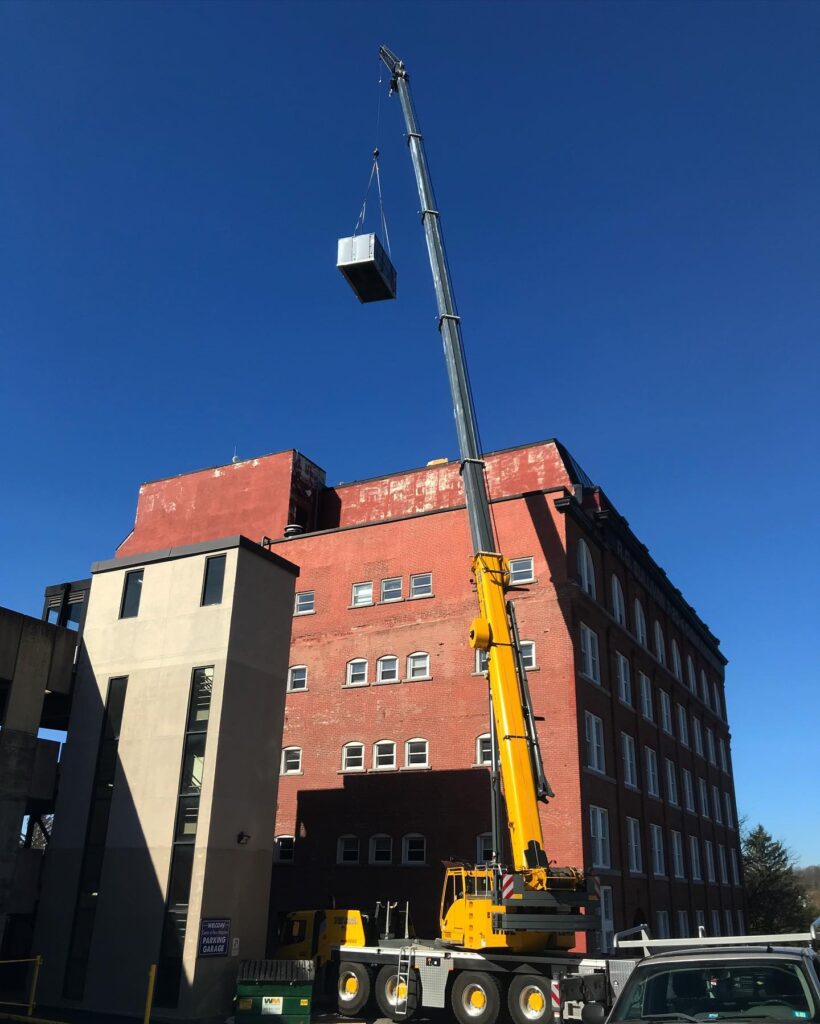
Will the material hold up once it’s welded? Is that beam size even available? How do we manage installation when crane access isn’t an option?
When a new project crosses our desk, these are the details we work through upfront.
Experience tells us that when you’re building something that weighs a few thousand pounds, you don’t get many second chances—and what looks good on a screen doesn’t always work in the real world.
As experienced industrial metal fabricators, we make sure it does.
What We Mean by ‘Heavy Plate’ and ‘Structural Weldments’
Unlike straightforward parts like handrails or vents, not every large metal part falls into a neat category. When we talk about heavy plate and structural weldments, we’re referring to custom-built frames, enclosures, or platforms—assemblies that are too heavy to lift by hand and too specific to come from a catalog. They’re built to hold equipment, support production, or house materials, and they often need forklifts or cranes just to move across the shop floor.
Why Experience Matters
One recent project involved six custom enclosures for a manufacturer working with plastic injection pellets. Each structure needed to support jib cranes, filtered air systems, and roll-up doors—all in a space that didn’t allow for crane access.
We started with a reference unit but redesigned nearly everything: how the pellets were loaded, how the frame was anchored, and how the panels were mounted. We worked closely with the client’s engineering team to get it right, because if we hadn’t, the parts might have shown up on-site and not fit. Or worse, they would’ve been impossible to install without tearing into the building.
At Macy Industries, this kind of hands-on design support is baked into every heavy fabrication project we take on. Before anything gets cut, we flag issues that could slow things down, like a hard-to-source beam size or a finish that won’t hold up. That’s how we keep complex jobs moving smoothly from start to finish.
The Materials and Sizes We Work With
Most structural weldments are made from heavy steel, which we cut and assemble in-house using equipment built for oversized work. Here’s what that typically looks like:
- Steel plate up to 1¼” thick, cut on our CNC plasma table
- Tubing, angle, and I-beams ranging from 8″ to 10″, depending on load requirements
- A36, G50, and AR plates, selected based on strength and wear considerations
We’ll often suggest alternate materials if the spec calls for something costly or difficult to source. And we’re not shy about overbuilding if it means peace of mind. If we’re wondering whether a 2″ tube is enough, we’ll go with a 3″ tube instead. The difference in cost is usually minor, but the added strength can make all the difference.
How We Build It
Every weldment we fabricate is built at our New Hampshire fabrication facility using equipment designed for scale, precision, and control.
- Cranes and forklifts move assemblies safely around the shop.
- Acorn tables hold parts steady and square during welding.
- Band saws and plasma tables handle all cutting, from heavy plate to structural tubing.
- MIG and TIG welding stations give us the flexibility to weld light and heavy parts alike.
Most builds start as subassemblies, which we fit together and weld out in stages. For jobs that require on-site installation, we typically do a partial shop assembly first to confirm everything aligns as expected.
How We Make Sure It’s Right
Small errors in fabrication can snowball fast, especially at this scale. That’s why our weld leads and supervisors stay involved throughout the build.
We use jigs and fixtures to align parts and prevent movement when introducing heat. We inspect every major weld for strength and appearance. And before anything leaves the shop, we check the final assembly for accuracy and squareness.
If we’re managing the installation, we handle anchoring and assembly on-site, using whatever tools the job requires—lifts, cranes, you name it. The goal is to make sure everything fits together the first time.
Why Clients Choose Macy Industries
When building structural weldments, you’re not just fabricating something heavy—you’re creating something that must function safely and reliably. That means it needs to fit right, hold up under pressure, and come together without surprises on install day.
That’s where our experience really matters.
As trusted industrial metal fabricators, we’ve handled enough of these projects to know how to spot problems early, work through unexpected challenges, and keep things moving without cutting corners. We’re used to working from half-finished drawings or legacy designs that need some extra thought. And we know how to pivot quickly when field conditions don’t match the original plan.
Because we manage everything in-house—design, fabrication, and installation—our clients don’t have to juggle vendors or chase down answers. They get one point of contact, clear communication, and a finished product they can count on.
Whether you’re planning a one-off enclosure, a production platform, or a custom frame, we’ll make sure it’s done right. Contact us to get started.
